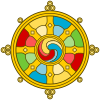
The Gelug is the newest of the four major schools of Tibetan Buddhism. It was founded by Je Tsongkhapa (1357–1419), a Tibetan philosopher, tantric yogi and lama and further expanded and developed by his disciples.

Geshe Kelsang Gyatso was a Buddhist monk, meditation teacher, scholar, and author. He was the founder and spiritual director of the New Kadampa Tradition-International Kadampa Buddhist Union (Function), a registered non-profit, modern Buddhist organization that came out of the Gelugpa school/lineage. They have 1,300 centres around the world, including temples, city temples and retreat centres that offer an accessible approach to ancient wisdom.

The Rimé movement is a movement or tendency in Tibetan Buddhism which promotes non-sectarianism and universalism. Teachers from all branches of Tibetan Buddhism – Sakya, Kagyu, Nyingma, Jonang, Gelug, and Bon – have been involved in the promoting Rimé ideals.
The Dorje Shugden controversy is a controversy over Dorje Shugden, also known as Dolgyal, whom some consider to be one of several protectors of the Gelug school, the school of Tibetan Buddhism to which the Dalai Lamas belong. Dorje Shugden has become the symbolic focal point of a conflict over the "purity" of the Gelug school and the inclusion of non-Gelug teachings, especially Nyingma ones.
The term New Kadampa is a synonym for the 14th century Gelug school of Tibetan Buddhism, as founded by Je Tsongkhapa. Being a great admirer of Kadam teachings, Je Tsongkhapa was an enthusiastic promoter of the 11th century Kadampa school's emphasis on the graded path to enlightenment and Mahayana principles of universal compassion as its fundamental spiritual orientation. Though the synonym is less well known in English-speaking countries, in Tibet the Gelugpa was well known as the "New Kadampa," while the earlier school was referred to as the "Ancient Kadampa" or "Original Kadampa". Je Tsongkhapa considered the New Kadampa tradition he founded to be the successor to Atiśa's Old Kadampa tradition. Geoffrey Samuels remarks that Tsongkhapa "was following in the footsteps of Atisha, and indeed the Gelugpa are sometimes known as the 'New Kadampa' and regarded themselves as above all a continuation of Atisha's work."

The 5th Dalai Lama, Ngawang Lobsang Gyatso was recognized as the 5th Dalai Lama, and he became the first Dalai Lama to hold both Tibet's political and spiritual leadership roles. He is often referred to simply as the Great Fifth, being the key religious and temporal leader of Tibetan Buddhism and Tibet. He is credited with unifying all of Tibet under the Ganden Phodrang, after Gushri Khan's successful military interventions. As an independent head of state, he established priest and patron relations with both Mongolia and the Qing dynasty simultaneously, and had positive relations with other neighboring countries. He began the custom of meeting early European explorers. The 5th Dalai Lama built the Potala Palace, and also wrote 24 volumes' worth of scholarly and religious works on a wide range of subjects.

The New Kadampa Tradition – International Kadampa Buddhist Union (NKT—IKBU) is a global Buddhist new religious movement founded by Kelsang Gyatso in England in 1991. In 2003 the words "International Kadampa Buddhist Union" (IKBU) were added to the original name "New Kadampa Tradition". The NKT-IKBU is an international organisation registered in England as a charitable, or non-profit, company. It currently lists more than 200 centres and around 900 branch classes/study groups in 40 countries. founded by the Tibetan-born Geshe Kelsang Gyatso, the BBC describes the New Kadampa Tradition as "one of the major Buddhist schools in the UK".
Geshe or geshema is a Tibetan Buddhist academic degree for monks and nuns. The degree is emphasized primarily by the Gelug lineage, but is also awarded in the Sakya and Bön traditions. The equivalent geshema degree is awarded to women.

Pabongkhapa Déchen Nyingpo was a Gelug lama of the modern era of Tibetan Buddhism. He attained his Geshe degree at Sera Mey Monastic University, Lhasa, and became a teacher in Tibet. He teaches lay people. Pabongkha was offered the regency of the present Dalai Lama but declined the request because "he strongly disliked political affairs."

The Nechung Oracle is the personal oracle of the Dalai Lama since the second Dalai Lama. The medium currently resides in Nechung Monastery established by the Dalai Lama in Dharamsala, India. The Nechung Oracle was the designated head of the Nechung monastery in Tibet.

Nechung Monastery, Nechung Gompa or Nechung Chok, is the seat of the State Oracle of Tibet. It is also referred to as Sungi Gyelpoi Tsenkar, the "Demon Fortress of the Oracle King."
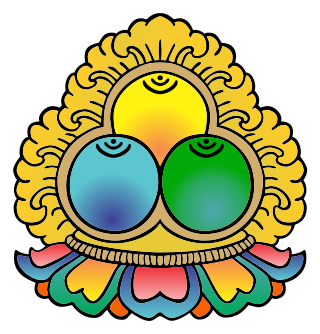
In Tibetan Buddhism, the Three Jewels and Three Roots are supports in which a Buddhist takes refuge by means of a prayer or recitation at the beginning of the day or of a practice session. The Three Jewels are the first and the Three Roots are the second set of three Tibetan Buddhist refuge formulations, the Outer, Inner and Secret forms of the Three Jewels. The 'Outer' form is the 'Triple Gem', the 'Inner' is the Three Roots and the 'Secret' form is the 'Three Bodies' or trikāya of a Buddha.
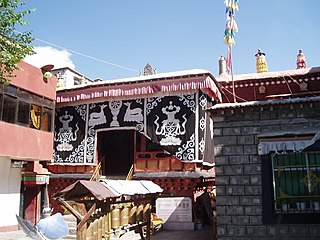
Trode Khangsar is a temple located in Lhasa, Tibet Autonomous Region, China, that is over 300 years old. The temple is dedicated to the protector Dorje Shugden and has been traditionally managed by the Gelug monastery Riwo Chöling, which is located in the Yarlung valley.

Trülku Drakpa Gyeltsen (1619–1656) was an important Gelugpa lama and a contemporary of the 5th Dalai Lama (1617–1682). His Seat was the upper residence of Drepung Monastery, a famous Gelug gompa located near Lhasa.
The Western Shugden Society was a campaign group that advocates Dorje Shugden, and which dissolved itself, along with its parent organisation, the International Shugden Community, after a 2015 Reuters investigation determined that the religious sect had the backing of the Chinese Communist Party and had emerged as an instrument in Beijing’s long campaign to undermine support for the Dalai Lama.
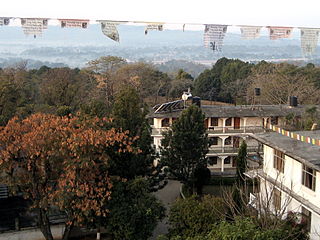
Lobsang Gyatso (1928–1997) was a Tibetan monk who founded the Institute of Buddhist Dialectics in Delhi, India.
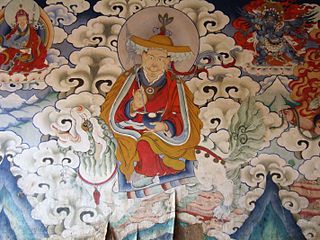
Gyalpo spirits are one of the eight classes of haughty gods and spirits in Tibetan mythology and religion. Gyalpo, a word which simply means "king" in the Tibetic languages, in Tibetan mythology is used to refer to the Four Heavenly Kings and especially to a class of spirits, both Buddhist and Bon, who may be either malevolent spirits or oath-bound as dharmapalas.

According to Tibetan Buddhist myth, Gyalpo Pehar is a spirit belonging to the gyalpo class. When Padmasambhava arrived in Tibet in the eighth century, he subdued all gyalpo spirits and put them under control of Gyalpo Pehar, who promised not to harm any sentient beings and was made the chief guardian spirit of Samye during the reign of Trisong Deutsen. Pehar is the leader of a band of five gyalpo spirits and would later become the protector deity of Nechung Monastery in the 17th century under the auspices of the Fifth Dalai Lama.
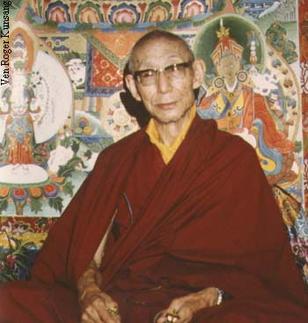
The Third Trijang Rinpoche, Lobsang Yeshe Tenzin Gyatso (1901–1981) was a Gelugpa Lama and a direct disciple of Pabongkhapa Déchen Nyingpo. He succeeded Ling Rinpoche as the junior tutor of the 14th Dalai Lama when the Dalai Lama was nineteen years old. He was also a lama of many Gelug lamas who taught in the West including Zong Rinpoche, Geshe Rabten, Lama Yeshe, Kelsang Gyatso, and Lama Zopa Rinpoche. Trijang Rinpoche's oral teachings were recorded by Zimey Rinpoche in a book called the Yellow Book.
Panchen Sonam Dragpa (1478–1554) was the fifteenth Ganden Tripa or throneholder of Ganden Monastery. His texts form the core curriculum for the Loseling College of Drepung Monastic University, the Shartse College of the Ganden Monastic University, and several other Gelugpa monasteries. He was taught by the second Dalai Lama and in turn later became the teacher of the third Dalai Lama.

